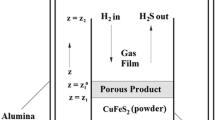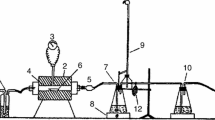Abstract
A thermodynamic and kinetic model is proposed to explain the formation of bornite, chalcopyrite, and magnetite during partial roasting of enargite-containing copper concentrates. The proposed mechanism involves solid–solid–gas and solid–gas reactions between chalcocite, pyrrhotite, gaseous sulfur, and oxygen. Bornite formation could be explained through a mechanism of simultaneous formation of bornite and chalcopyrite from Cu2S + FeS + gaseous sulfur. After the initial formation of a bornite/chalcopyrite layer, solid-state diffusion appears to control these reactions, with faster diffusion kinetics favoring the formation of chalcopyrite over that of bornite. The newly formed chalcopyrite reacts continuously with additional Cu2S to form bornite up to the complete disappearance of either the available Cu2S or FeS. Although thermodynamically the direct formation of bornite is more favorable than that of chalcopyrite, the lower diffusion kinetics of bornite formation could explain the preferential formation of chalcopyrite prior to the formation of bornite. Without enough chalcocite to form bornite by reaction with chalcopyrite, no bornite can be formed, leaving chalcopyrite as the only reaction product. In the presence of oxygen, chalcocite and pyrrhotite form magnetite, chalcopyrite, and SO2. The proposed model is thermodynamically consistent with the experimental results obtained in the laboratory.













Similar content being viewed by others
Notes
Enargite decomposes to intermediate tennantite, and tennantite to chalcocite and pyrrhotite, as found by Padilla et al.[10]
References
A. Björkman, U. Degerstedt, B. Lindblom, and C. Samuelsson: Extraction and Processing for the Treatment and Minimization of Wastes, J. Hager et al., eds., The Minerals, Metals and Material Soc., 1983, pp. 825–42.
S.A.I. Mäkipirtii: Process for the selective removal of impurities present in sulphidic complex ores, mixed ores or concentrates, U.S. Pat. 4,242,124, 1980.
I. Wilkomirsky, R. Parra, F. Parada, E. Balladares, J. Etcheverry and R. Díaz: 2018, (Unpublished research).
O.K. Kubaschewski and C.B. Alcock: Metallurgical Thermochemistry, 5th ed., Pergamon Press, 1979.
P. Couwe, P. Minet and R. Sheridan: in Advances in Sulphide Smelting, H.Y. Sohn et al., eds., The AIME Soc. Publ., 1983, pp. 427–49.
HSC Chemistry 6.0©, Outotec Oy, Finland.
L.J. Evrard: Journal of Metals, 2001, 53: 42-44.
FACTSAGE©, Software and Data Bases.
7. R. Padilla, Y. Fan and I. Wilkomirsky: Canadian Metallurgical Quarterly, 2001, Vol. 40,(3), pp. 335-342.
E. Seguel: Met. Engr. Thesis, University of Concepcion, Chile, 2018.
Acknowledgments
The authors wish to thank the DMH Division of CODELCO for permission to publish the experimental data and also to Conicyt/PIA for additional support through the CCTE AFB170007 program.
Author information
Authors and Affiliations
Corresponding author
Additional information
Publisher's Note
Springer Nature remains neutral with regard to jurisdictional claims in published maps and institutional affiliations.
Manuscript submitted April 5, 2019.
Appendix A
Appendix A
Notation
a | Moles of chalcocite per mole of sulfur (bornite formation) |
\( C_{{{\text{s}}_{2} }} \) | Concentration of gaseous sulfur in the gas phase 0.16 (atm) = 7.2 × 10−6 (mole/cu.cm) |
D e | Effective diffusion coefficient of gaseous sulfur (cm2/s) |
τ | Total reaction time of solid for complete conversion = 15 (min) = 900 (s) |
\( \bar{\rho }_{\text{s}} \) | Average density of solids = 4.5 (g/cu cm) ~ 3.58 10−2 (mole/cu cm) |
Rights and permissions
About this article
Cite this article
Wilkomirsky, I., Parra, R., Parada, F. et al. Thermodynamic and Kinetic Mechanisms of Bornite/Chalcopyrite/Magnetite Formation During Partial Roasting of High-Arsenic Copper Concentrates. Metall Mater Trans B 51, 1540–1551 (2020). https://doi.org/10.1007/s11663-020-01870-4
Received:
Published:
Issue Date:
DOI: https://doi.org/10.1007/s11663-020-01870-4




